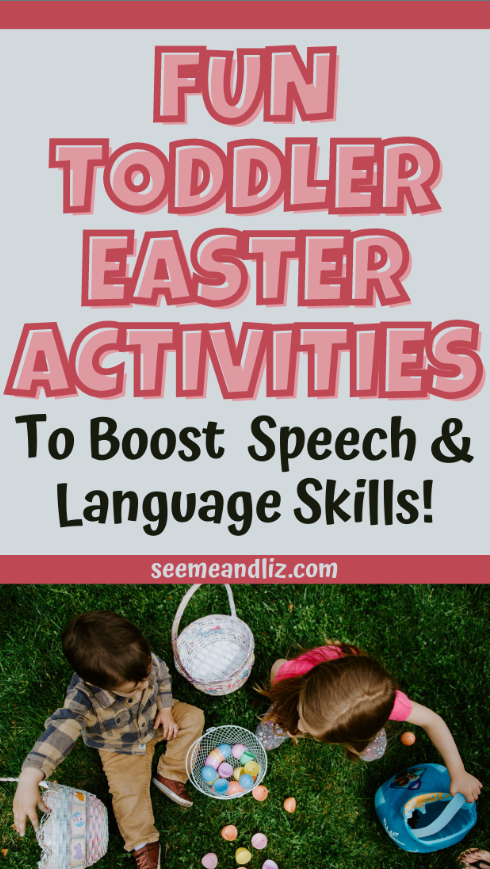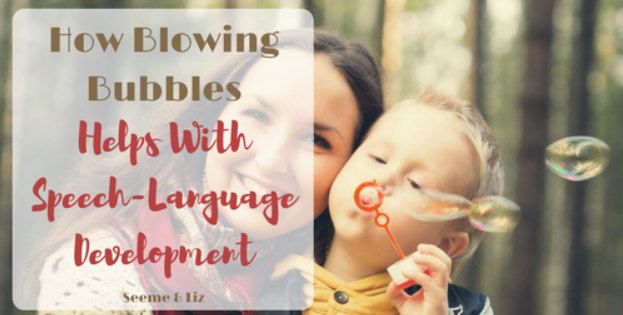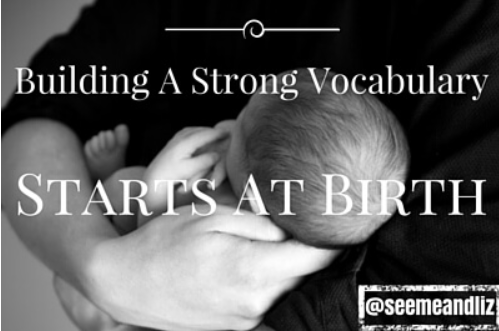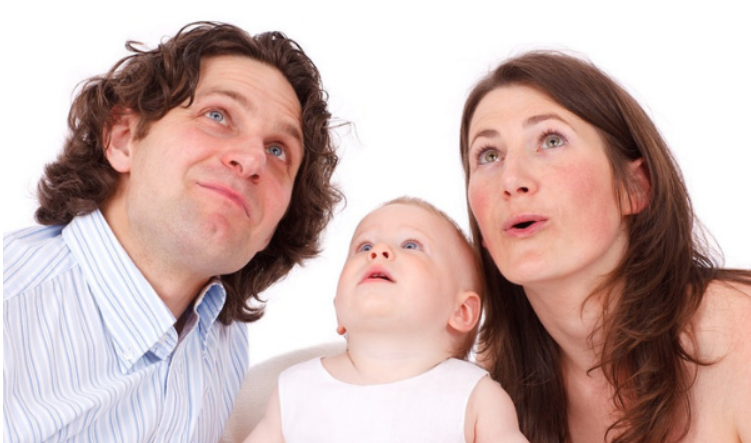Most children (that celebrate the holiday in some form) love Easter. And because of that there are some great learning opportunities that you can incorporate into toddler Easter activities! As you will learn from this article these activities do not need to be complicated.
In fact, there are probably many things you are already doing that will help with your toddler’s speech and language development.
Maybe you have added some Easter or Spring decorations around your house, perhaps you have started planning your Easter Sunday meal.
Did you know that while you are doing these things you can also help your toddler with their speech & language development?
There are so many new words that can be learned during various holidays, seasons and celebrations.
And if you want, throw in some guided play activities Easter themed activities as well.
I will discuss a few good ones and how you can turn them into wonderful opportunities to facilitate speech–language development.
If you are a preschool or kindergarten teacher you may also want to incorporate some of these suggestions into your classroom for fun hands on learning opportunities!
Simple Toddler Easter Activities To Promote Speech & Language Development
Repeat New Easter Related Words
Target common Easter vocabulary such as: bunny, basket, egg, grass, sun, hop, jump, hide, look for/find, etc.
If you are Religious you can focus on some religion specific Easter words.
Remember to choose words that won’t be too hard for your child to try to say on their own and that they have the opportunity to hear these words many times.
It’s also good to focus on functional words that will help with communication and in turn reduce frustration and tantrums.
Go For A Pretend Easter Egg Hunt
All you need are some plastic Easter eggs that open up, small dollar store toys (or pictures) and an Easter Basket.
Let your child know that this is a “pretend” Easter egg hunt.
You can call it an Easter game.
Find a few small toys that represent common words your child isn’t saying yet.
Some examples of first words include: cat, dog, apple, bug, shoe, tree, key, car, train, etc.
Download your complete list of the most common first words spoken by babies and toddlers below.
If you are having a hard time finding toys to represent these words, just print out pictures of them.
They are meant to go inside the Easter eggs.
Each time your child finds an egg you may prompt them to say “open” or “open egg”.
Once the egg is open they can try to say the word of what’s inside on their own or repeating after you. But if this is too challenging or if you aren’t sure if your child knows a particular word, wait until 3 eggs have been opened.
Lay out the 3 pictures or objects and ask your child “where is the _______?” and see if they can find it.
Or keep it even simpler by leaving the eggs empty.
But, each time your child finds an egg they can try repeating after you and saying “egg” or “I found (an) egg”.
Remember to keep the interactions fun and natural. If your child won’t repeat after you, don’t sweat it.
Just keep saying the target word/phrase and eventually they will pick it up.
Alternatively, you could put a treat such as a few cheerios in only certain eggs.
Your child could work on saying “empty” or “all gone” if there is nothing inside.
Targeting “open” and “close(d)” also works well for this game.
There are so many different ways that you can use these Easter eggs!
I used to do this activity in my speech–language sessions and even my youngest clients love it!
Pin The Tail On The Bunny
This is a simple activity but it will take a bit of prep work on your part.
Download the bunny pictures and instructions from From ABC’s To ACT’s.
Once you are ready, you and your child can take turns matching the bunny tail (pompon) color to the correct rabbit.
Each time your child takes a turn say “bunny” and encourage them to try saying “bunny” as well.
If your child is starting to combine words model a short phrase such as “green bunny tail” or “bunny hop (away)”.
If taking turns is a goal for your child then work on the phrases “my turn” and “your turn” as well.
You can also put all the “bunny tails” into a bag and have your child reach in to pick one out.
Each time they pull one out they could say “I found (a) bunny tail”, “I found (color name)” or “I see (color name or “bunny tail”).
These short phrases are known as “carrier phrases” by speech–language pathologists and are a great way to practice going from one word to 2–3 word sentences.
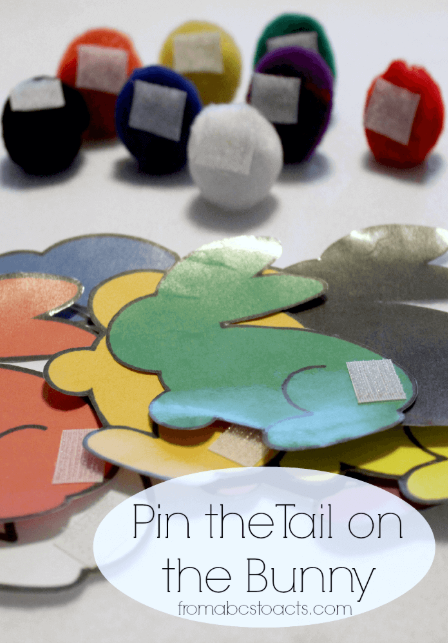
Easter Egg On A Spoon Race
All you need for this activity is a large wooden/plastic spoon and some plastic Easter eggs.
This will work well if your toddler has older siblings as they can participate.
Give your child a spoon and an egg and encourage them to walk fast or run across the room balancing the egg on the spoon.
This is great for practicing balance and hand eye coordination but it also works well for building vocabulary and expanding words into phrases.
If the egg falls off the spoon say “uh oh, the egg fell down” and then say “fall down”.
Your child may repeat “uh oh” or “fall down” or simply say “fall” or “down”.
It is important to model grammatically correct phrases, but if your child isn’t using many words, leaving out some grammar here and there (especially if the goal is having your child repeat you) is ok from time to time.
The goal here is to vocalize and perhaps learn a new word such as “egg”, “Easter egg”, “hop”, etc.
Head over to And Next Comes L for their “Wobbly Easter Egg” instructions that can make this activity more challenging from a motor development standpoint.
Scooping Plastic Eggs
You guessed it, you will need some plastic eggs again.
But the element of water is added to this activity because playing with water is a wonderful learning experience for toddlers.
Get a large plastic bin and toss in some big spoons for scooping, a colander, and a few cups.
And don’t forget the eggs. Then fill it with water.
This activity seems like it would be more for sensory and motor development however, you can incorporate language skills into it as well.
If you have some plastic ducks and bunnies throw them in too.
Label words your child might not be saying such as egg, bunny, duck, spoon, water, wet, dry (sink and float for older siblings).
You can encourage your child to try and “catch an egg (duck, bunny, etc.)”.
Have plenty of towels around because this will get messy.
Luckily it’s only water and can be cleaned up easily.
Speech Development With Easter Activities
So far I have really only talked about how to incorporate language development into these activities.
A toddler’s speech sound production is not expected to be clear; in fact, many sounds don’t develop properly until a child is over the age of 3.
However, there are certain sounds a child should be saying clearly by the age of 2–2.5. Some of these early sounds include p, b, m, n, h, t, d and a few vowels.
Easter activities for young children lend themselves well to practicing sounds like “b” – bunny, “h” – hop, “e” – egg, “o” – open, “d” – duck.
Final Thoughts
As you can see, it isn’t very difficult to add a speech–language focus to toddler Easter activities.
Whether it be a craft, game or sensory play, language building opportunities are everywhere.
Don’t forget to download the 85 Most Common First Words to help you figure out some words your little one might need to hear more often!
And if you are concerned about your child’s speech–language development take them to a licensed Speech–Language Pathologist for an evaluation.
In North America there are many facilities that offer FREE speech–language services for children 3 and under.
However there will be wait lists.
If you have private insurance coverage there is a good chance that an Assessment and potentially some therapy sessions would be covered.

